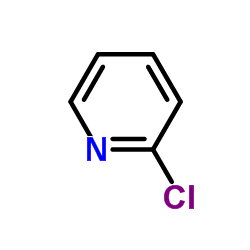2-Chloropyridine

2-Chloropyridine structure
|
Common Name | 2-Chloropyridine | ||
|---|---|---|---|---|
| CAS Number | 109-09-1 | Molecular Weight | 113.545 | |
| Density | 1.2±0.1 g/cm3 | Boiling Point | 170.0±0.0 °C at 760 mmHg | |
| Molecular Formula | C5H4ClN | Melting Point | -46 °C | |
| MSDS | Chinese USA | Flash Point | 65.0±0.0 °C | |
| Symbol |




GHS05, GHS06, GHS08, GHS09 |
Signal Word | Danger | |
|
Synthesis, biological evaluation, and molecular docking studies of 2-chloropyridine derivatives possessing 1,3,4-oxadiazole moiety as potential antitumor agents
Bioorg. Med. Chem. 18 , 7836-41, (2010) Antiproliferative assay results indicated that compounds 6o and 6u exhibited the most potent activity against gastric cancer cell SGC-7901, which was more potent than the positive control. Especially, compound 6o exhibited significant telomerase inhibitory ac... |
|
|
Synthesis and molecular docking studies of novel 2-chloro-pyridine derivatives containing flavone moieties as potential antitumor agents.
Bioorg. Med. Chem. Lett. 20 , 4163-4167, (2010) A series of novel 2-chloro-pyridine derivatives containing flavone, chrome or dihydropyrazole moieties as potential telomerase inhibitors were synthesized. The bioassay tests showed that compounds 6e and 6f exhibited some effect against gastric cancer cell SG... |
|
|
Detailed compositional characterization of plastic waste pyrolysis oil by comprehensive two-dimensional gas-chromatography coupled to multiple detectors.
J. Chromatogr. A. 1359 , 237-46, (2014) The detailed compositional characterization of plastic waste pyrolysis oil was performed with comprehensive two-dimensional GC (GC×GC) coupled to four different detectors: a flame ionization detector (FID), a sulfur chemiluminescence detector (SCD), a nitroge... |
|
|
Toward prediction of alkane/water partition coefficients.
J. Med. Chem. 51 , 3720-30, (2008) Partition coefficients were measured for 47 compounds in the hexadecane/water ( P hxd) and 1-octanol/water ( P oct) systems. Some types of hydrogen bond acceptor presented by these compounds to the partitioning systems are not well represented in the literatu... |
|
|
Methods for differential and quantitative analyses of brain neurosteroid levels by LC/MS/MS with ESI-enhancing and isotope-coded derivatization.
J. Pharm. Biomed. Anal. 117 , 155-62, (2015) The analysis of changes in the brain neurosteroid (NS) levels due to various stimuli can contribute to the elucidation of their physiological roles, and the discovery and development of new antipsychotic agents targeting neurosteroidogenesis. We developed met... |
|
|
The synthesis and preclinical evaluation in rhesus monkey of [¹⁸F]MK-6577 and [¹¹C]CMPyPB glycine transporter 1 positron emission tomography radiotracers.
Synapse 65(4) , 261-70, (2011) Two positron emission tomography radiotracers for the glycine transporter 1 (GlyT1) are reported here. Each radiotracer is a propylsulfonamide-containing benzamide and was labeled with either carbon-11 or fluorine-18. [¹¹C]CMPyPB was synthesized by the alkyla... |
|
|
Contribution of N-oxidation and .OH radicals to mutagenesis of 2-chloropyridine in Salmonella typhimurium.
Acta Biochim. Pol. 40(1) , 57-9, (1993)
|
|
|
Palladium-catalyzed chemoselective monoarylation of hydrazides for the synthesis of [1,2,4]triazolo[4,3-a]pyridines.
Org. Lett. 12(4) , 792-5, (2010) An efficient and convenient method for the synthesis of [1,2,4]triazolo[4,3-a]pyridines was exemplified by the synthesis of 20 analogues bearing a variety of substituents at the 3-position. The methodology involves a palladium-catalyzed addition of hydrazides... |
|
|
Photolytic removal and mineralisation of 2-halogenated pyridines
Water Res. 43(16) , 3964-73, (2009) The photolytic destruction and mineralisation of 2-halogenated pyridines (2-HalPYs) was studied in a range of conditions by means of ultraviolet irradiation at 254 nm. In all cases pseudo-first order kinetics satisfactorily describe the degradation process. K... |
|
|
Photolytic (UVC) and photocatalyic (UVC/TiO2) decomposition of pyridines.
J. Hazard. Mater. 146(3) , 640-5, (2007) The degradation of 2-chloropyridine (2-CPY) and its degradation primary product 2-hydroxypyridine (2-HPY) was studied by means of ultraviolet (UV) irradiation at 254nm. Photolytic and photocatalytic experiments were conducted on 2-CPY and 2-HPY aqueous soluti... |